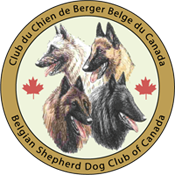Canadian Kennel Club Official Breed Standard
Belgian Shepherd Dog - Group 7 Herding Dogs
Origin and Purpose
The Belgian Shepherd Dog has an ancestry which is common to many of the herding dogs used throughout the modern world. His type is a result of the rugged Belgian climate and the requirements of the Belgian shepherd for a bright, strong, and agile dog. In addition to sheep herding, the Belgian Shepherd Dog has been widely used for police and war work and is noted for his intelligence and alertness in obedience work.
General Appearance
The first impression of the Belgian Shepherd Dog should be that of a well-balanced square dog, elegant in appearance, with an exceedingly proud carriage of head and neck. He should be a strong, agile, well-muscled animal who is alert and full of life. His whole conformation should give the impression of depth and solidity without bulkiness. The dog should be somewhat more impressive and grand than the bitch. The bitch should have a distinctively feminine look. Like many European breeds, different coat colours, textures, and lengths were preferred by the original fanciers. Today, however, only four distinct coat types are recognized and have become the distinguishing characteristics of the four varieties of Belgian Shepherd Dog. The long-haired Groenendael and Tervuren, the short-haired Malinois, and the rough-haired Laeken variety differ in coat colour, length and texture but are unmistakably the same breed.
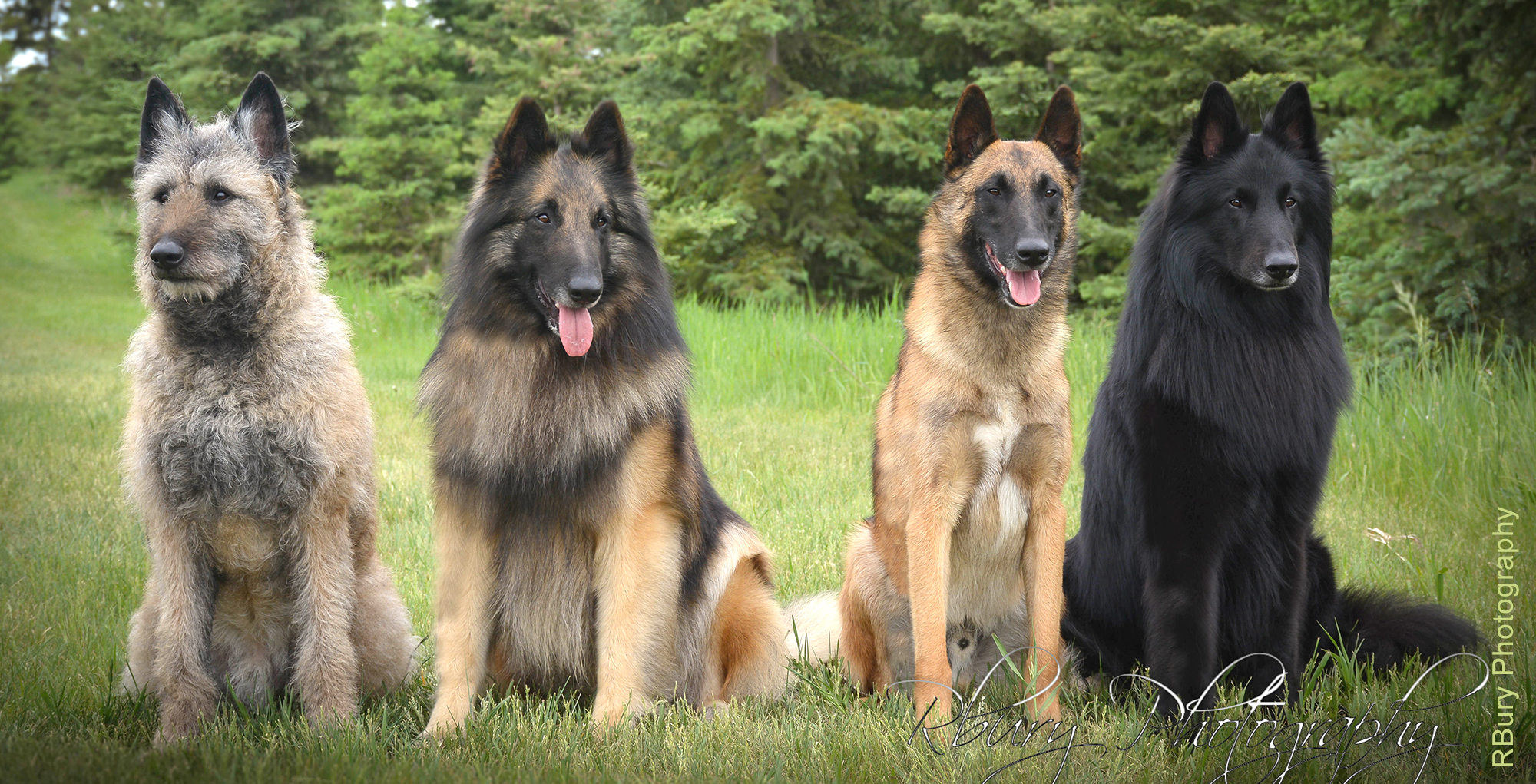
Temperament
The Belgian Shepherd Dog should reflect the qualities of intelligence, courage, alertness, and devotion to his master. To his inherent aptitude as guardian of flocks should be added protectiveness of the person and property of his master. He should be watchful, attentive, and always in motion when not under command. In his relationship with humans, he should be observant and vigilant with strangers but not apprehensive. He should not show fear or shyness. He should not show viciousness by unwarranted or unprovoked attack. With those he knows well, he is most affectionate, friendly, zealous of their attention, and very possessive.
Size
Males should be 24-26 inches (61-66 cm) in height and females 22-24 inches (56-61 cm) measured at the withers. The length, measured from the front of the forechest to the rear projection of the pelvis, should equal the height. Bitches may be slightly longer. Bone structure should be moderately heavy in proportion to height so that he is well balanced throughout and neither spindly and leggy nor cumbersome and bulky.
Coat and Colour
Coat length, colour, and texture is the one distinguishing feature between the different varieties of the Belgian Shepherd Dog.
(a) Long-haired
The guard hairs of the coat must be long, well fitting, straight and abundant. The texture should be a medium harshness. The undercoat should be extremely dense, commensurate, however, with climatic conditions. The hair is shorter on the head, outside of the ears, and lower part of the legs. The opening of the ear is protected by tufts of hair. There should be long and abundant hair forming a collarette around the neck; forming a fringe along the back of the forearm; forming the breeches in the hindquarters and forming a nicely plumed tail. Two colour types are found in the long-haired variety:
 (i) The dog should be completely black or be black with white limited as follows: small to moderate patch on forechest, between the pads of the feet, on tips of hind toes, and frost on the chin and muzzle. White on the tips of the front toes is allowable but is a fault. The black, long-haired variety is known as GROENENDAEL.
(i) The dog should be completely black or be black with white limited as follows: small to moderate patch on forechest, between the pads of the feet, on tips of hind toes, and frost on the chin and muzzle. White on the tips of the front toes is allowable but is a fault. The black, long-haired variety is known as GROENENDAEL.
(ii) The dog should be either rich fawn to russet mahogany or distinctly grey, each with a black overlay. The coat is characteristically double pigmented, wherein the tip of each hair is blackened.
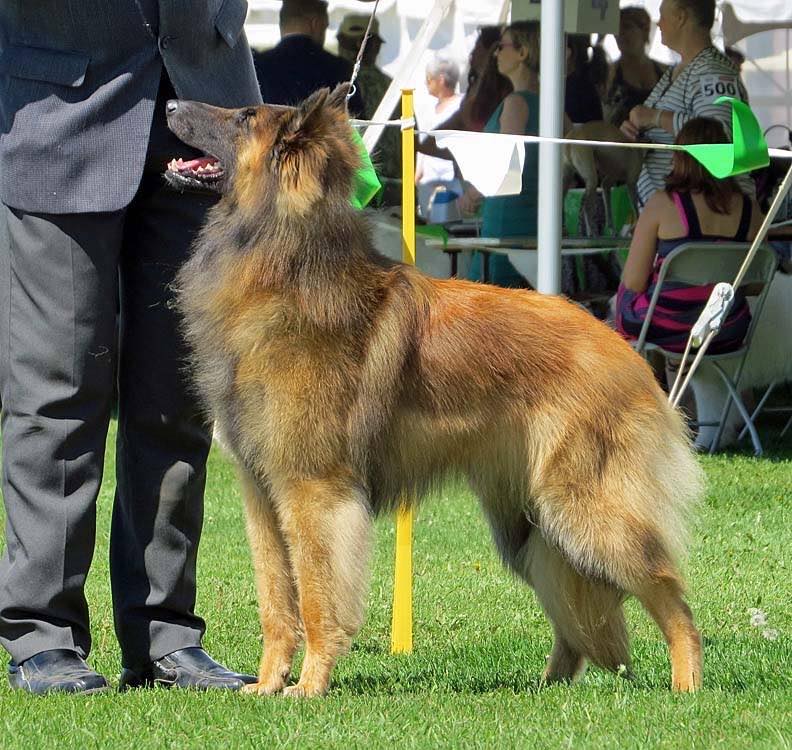 On mature males, this blackening is especially pronounced on the shoulders, back, and rib section. The chest colour is a mixture of black and grey. The face has a black mask and the ears are mostly black. The underparts of the dog, tail, and breeches are light beige or grey. A small white patch is permitted on the chest but should not extend into the neck or breast. Frost on the chin or muzzle is normal. Too light a colour or too black a colour is a serious fault. This variety is known as the TERVUREN.
On mature males, this blackening is especially pronounced on the shoulders, back, and rib section. The chest colour is a mixture of black and grey. The face has a black mask and the ears are mostly black. The underparts of the dog, tail, and breeches are light beige or grey. A small white patch is permitted on the chest but should not extend into the neck or breast. Frost on the chin or muzzle is normal. Too light a colour or too black a colour is a serious fault. This variety is known as the TERVUREN. (b) Short-haired
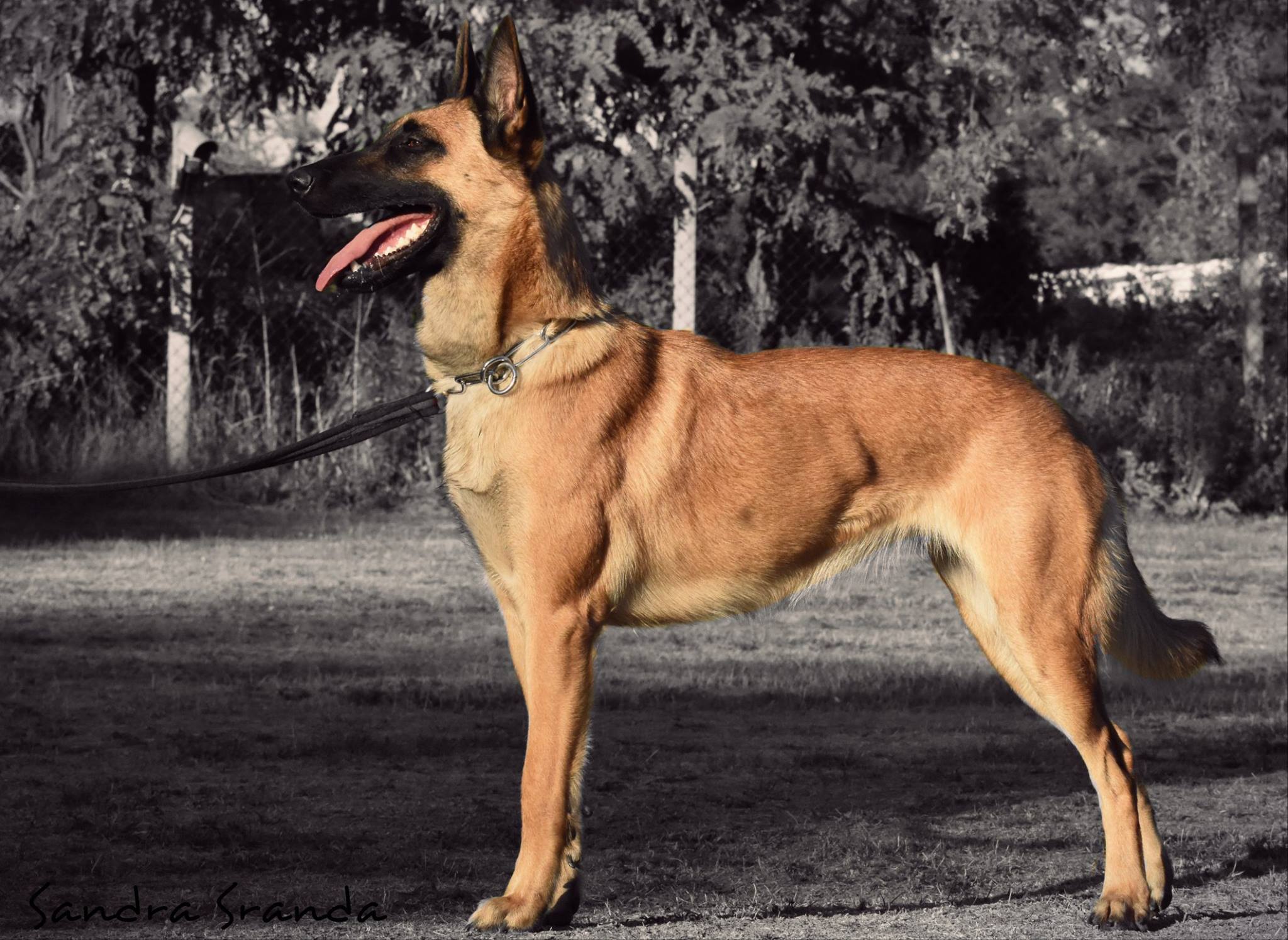 The coat should be comparatively short and straight with a dense undercoat. It is very short on the head, the ears and lower legs. The hair is somewhat longer around the neck where it forms a collarette and on the tail and back of the thighs. The colour should be from a rich fawn to mahogany with a black overlay. There should be a black mask and black ears. The underparts of the body, tail, and breeches are lighter fawn. A small white patch on the chest is permissible as is white on the tips of the toes. A washed-out fawn colour is undesirable. This variety is known as the MALINOIS.
The coat should be comparatively short and straight with a dense undercoat. It is very short on the head, the ears and lower legs. The hair is somewhat longer around the neck where it forms a collarette and on the tail and back of the thighs. The colour should be from a rich fawn to mahogany with a black overlay. There should be a black mask and black ears. The underparts of the body, tail, and breeches are lighter fawn. A small white patch on the chest is permissible as is white on the tips of the toes. A washed-out fawn colour is undesirable. This variety is known as the MALINOIS.(c) Rough-haired
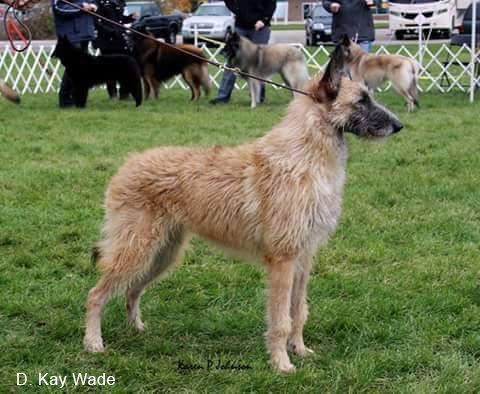 The coat should have a rough or dry texture and appear unkempt. The undercoat is thick and woolly. The coat is of medium length on all parts of the body except the head where the hair on the skull is short while the hair on the muzzle is slightly longer forming a beard or whiskers. The coat should be light fawn to red brown in colour. Grey is acceptable as well. Blackening may appear on the muzzle, ears, and tail. The underparts of the dog, tail, and breeches are light beige or grey. The tail should not form a plume. A small amount of white is permitted on the chest and the tips of the toes. This variety is known as the LAEKEN.
The coat should have a rough or dry texture and appear unkempt. The undercoat is thick and woolly. The coat is of medium length on all parts of the body except the head where the hair on the skull is short while the hair on the muzzle is slightly longer forming a beard or whiskers. The coat should be light fawn to red brown in colour. Grey is acceptable as well. Blackening may appear on the muzzle, ears, and tail. The underparts of the dog, tail, and breeches are light beige or grey. The tail should not form a plume. A small amount of white is permitted on the chest and the tips of the toes. This variety is known as the LAEKEN.Head
Should be clean-cut and strong with size in proportion to the body.
Skull
should be flattened on top rather than rounded. The width should be approximately the same as, but not wider than the length. The stop should be moderate.
Muzzle
should be moderately pointed, avoiding any tendency to snipiness, and approximately equal in length to that of the top skull.
Nose
should be black without spots or discoloured areas.
Mouth
the jaw should be strong and powerful. The lips should be tight and black with no pink showing on the outside. There should be a full complement of strong, white, evenly-set teeth. There should be either an even or a scissors bite. An overshot or undershot bite is a serious fault.
Eyes
should be dark brown, medium sized, slightly almond shaped and should not protrude.
Ears
should be triangular in shape, stiff, erect, and in proportion in size to the head. The base of the ear should not come below the centre of the eye.
Neck
Should be round and rather outstretched, tapered from head to body and well muscled with tight skin.
Body
Forequarters
Chest should be deep but not broad. The lowest point should reach the elbow of the front leg and should form a smooth ascending curve to the abdomen. Shoulder should be long and oblique, laid flat against the body and should form a sharp angle (approximately 90 degrees) with the upper arm. Legs should be straight, strong and parallel to each other. The bone should be oval rather than round. The length should be in proportion to the size of the dog. Pasterns should be of medium length and should be strong and very slightly sloped.
Back
Should be level, straight and firm from withers to hip. The withers should be slightly higher than and slope into the back.
Loin
The loin section viewed from above should be relatively short, broad, and strong, and should blend smoothly into the back. The abdomen should be moderately developed and should be neither tucked up nor paunchy.
Hindquarters
Croup Should be medium long with a gradual slope. Thighs should be broad and heavily muscled. The upper and lower thigh bones from a relatively sharp angle at the stifle joint. Hocks: the angle at the bock is relatively sharp although the angulation is not extreme. Metatarsus should be of medium length, strong, and slightly sloped. Dewclaws, if any may be removed.
Tail
Should be strong at the base and the bone should reach the hock. At rest, it should be held low and in action it should be raised with a slight curl which is strongest toward the tip. It should not curl over the dog’s back or form a hook.
Feet
The front feet should be round (cat-footed). The rear feet should be slightly elongated. Toes on both front and back feet should be curved and close together. They should be well padded. Nails should be strong and black except that they may be white to match white toe tips.
Gait
Should be smooth, free and easy, seemingly never tiring and exhibiting facility of movement rather than a hard driving action. He should single track on a fast gait – i.e., the legs, both front and rear, converge toward the centre line of the body. The backline should remain firm and level, parallel to the line of motion, with no crabbing. He should show a marked tendency to move in a circle rather than a straight line.
Faults
Any deviation from these specifications is a fault. In determining whether a fault is minor, serious, or major, these two factors should be used as a guide:
(a) The extent to which it deviates from the standard.
(b) The extent to which such deviation would actually affect the working ability of the dog.
Disqualifications
(a) Viciousness.
(b) Excessive shyness.
(c) Any colour or colour combination not allowed in the standard.
(d) Ears hanging (as on a hound).
(e) Tail cropped or stump.
(f) Males under 23 inches (58 cm) or over 27 inches (69 cm) in height. Females under 21 inches (53 cm) or over 25 inches (64 cm) in height.
